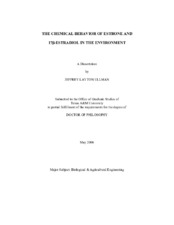| dc.description.abstract | The endogenous hormones estrone and 17β-estradiol support vertebrate growth and development, but slight increases above ambient concentrations may paradoxically induce endocrine disruption, leading to increased frequencies of reproductive disorders and cancer in humans and wildlife. Livestock excrete estrogenic compounds which can lead to surface and groundwater contamination. Limited information exists concerning estrogen fate and transport, as exposure concerns have recently arisen. This study examined the chemical behavior of estrone and 17β-estradiol with the goal of elucidating manure management principles applicable to animal feeding operations (AFOs). Both compounds indicated that they are susceptible to physicochemical and biological decomposition. Photolysis yielded 27- and 35-day half-lives for estrone and 17β-estradiol at pH 7, respectively, based on test conditions. 17β-estradiol photolysis exhibited a slight pH-dependent behavior. Mineralization produced half-lives ranging from 7 to 15 days for estrone and 3 to 7 days for 17β-estradiol. Indigenous microbial populations did not demonstrate a lag phase and therefore appeared to have been well acclimated to degrading these compounds. Anaerobic lagoon supplements did not affect mineralization rates. The compounds had partition coefficients ranging from 2 to 4.4 mL g-1, depending on soil characteristics. Estrone and 17β-estradiol had a higher absorptivity to soils with greater clay content and organic matter. Once sorbed, binding appeared largely irreversible with minimal desorption. Column experiments detected no estrone in the leachate for the finer textured soils, while estrone had completely migrated through the loamy fine sand after 7 pore volumes. Hypothetical scenarios, simulated using HYDRUS-1D, evaluated the combined effects of soil texture and the values obtained for sorption and mineralization on leaching. Model results indicated rapid leaching in loamy sand, while sandy clay loam and clay yielded significantly slower estrone and 17β-estradiol movement with concentrations 1 to 3 orders of magnitude lower. Data suggest that estrogens applied to sandy soil may leach and contaminate groundwater, especially in the presence of shallow water tables. Sandy clay loam and clay likely present minimal risk for subsurface mobility, but simulated accumulation near the soil surface may promote transport via overland flow. Sound manure management practices will likely reduce off-site transport of estrogens originating from AFOs. | en |


